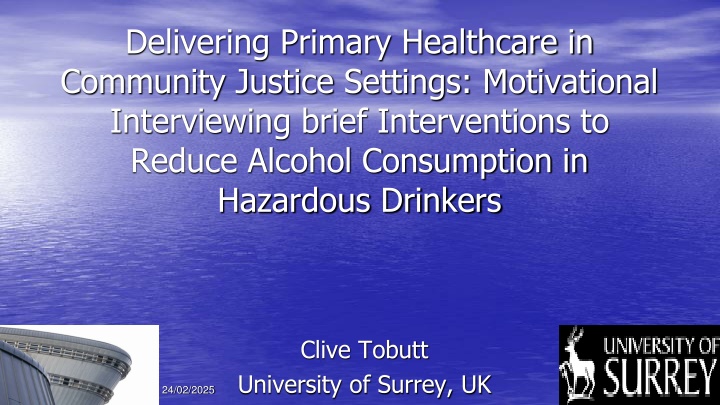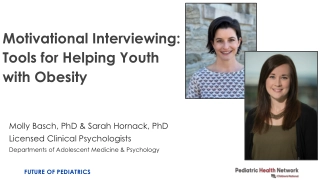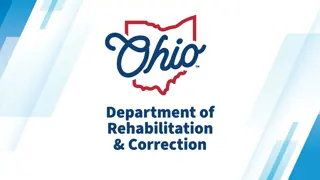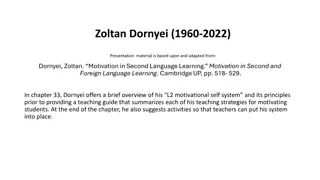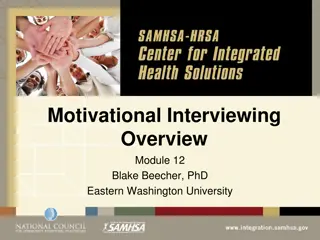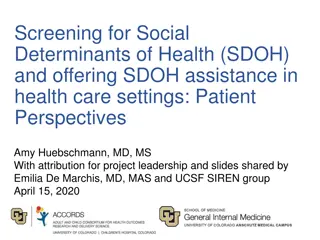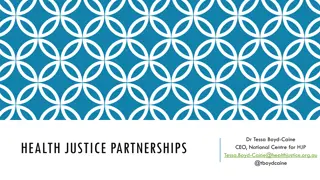Delivering Primary Healthcare in Community Justice Settings: Motivational Interviewing Brief Interventions
Brief overview of evidence for alcohol screening and interventions in Criminal Justice Settings in the UK. Explore Motivational Interviewing for reducing alcohol consumption in hazardous drinkers, targeting those with alcohol-related offenses. Review the prevalence of Alcohol Use Disorders, effectiveness of Brief Interventions, and gaps in the current evidence. Learn about ongoing research to enhance alcohol interventions in criminal justice contexts.
Download Presentation

Please find below an Image/Link to download the presentation.
The content on the website is provided AS IS for your information and personal use only. It may not be sold, licensed, or shared on other websites without obtaining consent from the author.If you encounter any issues during the download, it is possible that the publisher has removed the file from their server.
You are allowed to download the files provided on this website for personal or commercial use, subject to the condition that they are used lawfully. All files are the property of their respective owners.
The content on the website is provided AS IS for your information and personal use only. It may not be sold, licensed, or shared on other websites without obtaining consent from the author.
E N D
Presentation Transcript
Delivering Primary Healthcare in Community Justice Settings: Motivational Interviewing brief Interventions to Reduce Alcohol Consumption in Hazardous Drinkers Clive Tobutt University of Surrey, UK 1 24/02/2025
Aim of Talk To give a brief overview of current evidence for alcohol screening and brief interventions to reduce alcohol consumption for hazardous drinkers in Community Criminal Justice Settings (CJS) in the UK How Screening and Motivational Interviewing Brief Interventions may be used for those charged with alcohol-related offences in opportunistic teaching moments in CJS practice 24/02/2025 2
Scientific Background 25% prevalence rate of Alcohol Use Disorders (AUD) in the UK population (HSCIC, 2015) Higher prevalence rates of problem AUD in criminal justice settings (Parkes, MacAskill, Brookes, Jepson, et al., 2011) Complex relationship between alcohol use and offending behaviours (Boden, Fegusson & Horwood, 2012) British Crime Survey estimates that up to 50% of violent crime is related to AUD (Flatley, Kershaw, Smith Chaplin, et al., 2010) 3 24/02/2025
Alcohol Brief Intervention and the CJS: What is Known A recent UK systematic review on the prevalence of AUD and the effectiveness of BI across CJS settings (Custody Suite, Prison and Probation) ranged from 51% to 95% (Newbury-Birch, McGovern, Birch, O Neill, et al., 2016) Limited evidence of effectiveness of BI for reduced alcohol consumption However, SIPS Trial found reduction in offending rates (Newbury-Birch, Coulton, Bland, Cassidy, et al., 2014) 4 24/02/2025
Other Evidence More focussed intensive interventions such as Motivational Interviewing (MI) are effective in reducing alcohol consumption and related harms in CJS settings (Tobutt & Milani, 2010; Andrews & Bonta, 2010) There is alcohol SBI focusing on young people (18-30) in the CJS (Foxcroft, Smith, Thomas & Howcutt, 2015; Patton & Boniface, 2015) 24/02/2025 5
Gaps in the Evidence of Alcohol SBI & the CJS University of Surrey, University of Winchester & University of Southampton are proposing to undertake a mapping exercise of the offender (and victim) journey (from crime to time ) in UK CJS settings To determine novel opportunities (locations, sub- populations young people) to identify AUD and deliver MI SBI 24/02/2025 6
Health & Justice Care Pathway Public Health England, 2016 24/02/2025 7
24/02/2025 10
24/02/2025 11
24/02/2025 12
24/02/2025 13
24/02/2025 14
24/02/2025 15
24/02/2025 16
24/02/2025 17
Summary Limited evidence of SBI in CJS to reduce alcohol consumption and related harms in the UK Opportunity to use MI SBI in CJS to reduce alcohol consumption and alcohol-related harm by mapping the UK offender s journey to ascertain opportunities for novel intervention 24/02/2025 18
References Andrews, D., & Bonta, J. (2010) Rehabilitating criminal justice policy and practice. Psychology, Public Policy and Law, 16(1): 39-55. Boden, J., Fergusson, D., & Horwood, A. (2012) Alcohol misuse and violent behaviour: findings from a 30-year longitudinal study. Drug & Alcohol Dependence, 122(1-2): 135-41. Flatley, J., Kershaw, C, Smith, K., Chaplin, R., & Moon, D. (2010) Crime in England and Wales 2009/10. London: Home Office. 24/02/2025 19
Foxcroft, D., Smith, L., Thomas, H., & Howcutt, S. (2015) Accuracy of Alcohol Use Disorders Identification Test for detecting problem drinking in 18-35 year-olds in England: method comparison study. Alcohol and Alcoholism 50(2): 244-250. Health & Social Care Information Centre (2015) Statistics on Alcohol, England 2015. London: National Statistics Publication. Parkes, T., MacAskill, S., Brooks, O., Jepson, R., Atherton,I., Doi, L., McGhee, S., & Edie, D. (2011) Prison Health Needs Assessment for Alcohol Problems. Stirling, NHS Health Scotland. Newbury-Birch, D., McGovern, R., Birch, J., O'Neill, G., Kaner, H., Sondhi, A., & Lynch, K. (2016) A rapid systematic review of what we know about alcohol use disorders and brief interventions in the criminal justice system. International Journal of Prisoner Health, 12(1): 57-70. 20
Newbury-Birch, D., Coulton, S., Bland, M., Cassidy, P., Dale, V., Deluca, P., Gilvarry, E., Godfrey, C., Heather, N., Kaner, E., McGovern, R., Myles, J., Oyefeso, A., Parrot, S., Patton, R., Perryman, K., Phillips, T, Shepherd, J., & Drummond, C. (2015) Alcohol screening and brief interventions for offenders in the probation setting (SIPS Trial): a pragmatic multicentre cluster randomised controlled trial. Alcohol & Alcoholism, 49(5): 540-548. Paton, R., & Boniface, S. (2015) Prevalence of hazardous drinking among UK 18-35 year olds; the impact of a revision to the AUDIT Cut Score. Alcohol and Alcoholism, 1-2.10.1093/alcalc/agv115. Patton, R. (2014) Alcohol-related presentations to the emergency department among young people: some concerns. Emergency Medicine Journal, 31(3) doi:10.1136/emermed-2013-203317. 21
Public Health England (2016) Public Health Outcomes Framework February 2016. Available at: https://www.gov.uk/government/uploads/system/uploads/attachment_data/f ile/496588/Official_statistics_short_commentary_PHOF_February_2016.pdf Tobutt, C., & Milani, M. (2010) Comparing two counselling styles for hazardous drinkers charged with alcohol-related offences in a police-custody suite: piloting motivational interviewing brief intervention or a standard intervention to reduce alcohol consumption. Advances in Dual Diagnosis Journal, 3(4): 20-32. 22
